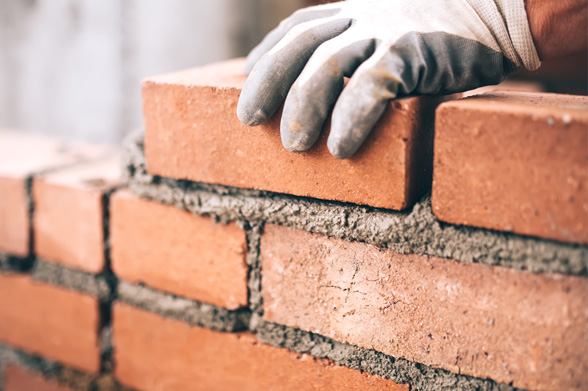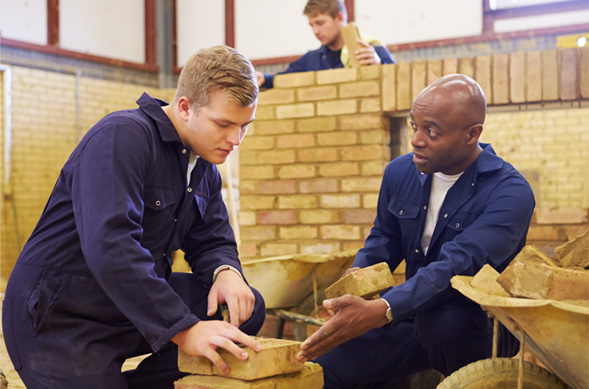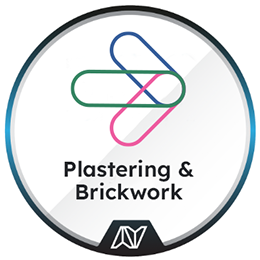
minutes average completion time
Plastering, Brickwork & Carpentry
In this micro course, we will introduce you to Plastering, Brickwork & Carpentry, which will help you gain the necessary hand skills and theoretical knowledge required to gain employment in the construction industry.
What is Plastering
Plastering is a vital part of the construction and interior design industries and has been used for centuries.
A plasterer is a tradesperson who works with “plaster” (gypsum, sand & lime or cement) forming a layers of “plaster” on interior or exterior walls and ceilings. Cutting and fixing “plaster board” and creating plaster decorative mouldings.
- Plastering is the first of the finishing trades
- In the UK, an entry-level plasterer might earn between £18,000 and £22,000 annually. As you gain experience and your skills improve, your earnings can rise to between £25,000 and £40,000 per year
- Plastering improves the functionality of a building
by making it stronger, more insulated, soundproofed, and fireproofed - Plastering can also be used to create decorative designs on walls and ceilings
- Due to a skills gap in the construction sector, qualified plasterers are always in demand for both domestic and commercial projects.
- There are around 40,000 plasterers in the UK
- Many plasterers are self-employed

What Skills Do Employers Look For?
Plastering is a physically demanding and highly skilled job. Employers look for individuals with the following abilities:
A strong work ethic:
Workers should be punctual and reliable as well as professional and positive.
Health and Safety Awareness:
Plasterers must understand and follow strict health and safety guidelines to prevent accidents, such as working at height and manual handling.
Attention to Detail:
Plastering is about precision. Whether you’re preparing walls or ceilings, cutting and fixing beads or plaster boarding everything needs to be done with careful planning.
Teamwork and Communication:
Plasterers often work in teams to complete tasks. Effective communication and collaboration with other trades on site are essential for success.
Problem-Solving:
On the job, you’ll often need to adapt to unexpected issues or handling weather-related delays.
What are the tools a Plasterer uses?
Common Plastering tools include:
Plastering Trowels:
A flat, rectangular, or diamond-shaped blade that applies and smooths plaster.
Plastering Hawk:
A flat board for holding plaster, mortar, or cement while applying.
Bucket Trowel:
A wide-bladed trowel for scooping plaster from a bucket.
Plaster Mixer:
For mixing plaster, adhesives, mortar, concrete and other substrates easily and quickly.
Plastering is a vital part of the construction and interior design industries and has been used for centuries.

Did you know?
Plastering is an ancient technique, dating back to the time of the pyramids and the construction of Rome. The Ancient Egyptians were masters of plastering.
Plastering at College
Plastering is a one-year course (per level) aimed at those looking to work in the construction industry specifically as a craftsperson in plastering.
You can expect a combination of practical and theoretical learning to give you a good degree of knowledge and practice in this tricky but satisfying art form. It is a practical based course (70%) which teaches students how to mix, apply, and finish plaster on walls and ceilings. Plastering courses can be for beginners, hobbyists, or those looking to pursue a career in plastering.
- Learning plastering in college can help you develop skills for a rewarding career, save money on DIY projects, and build confidence.
- Qualified plasterers are significantly more likely to find employment in the UK, as the construction industry consistently experiences a shortage of skilled plasterers, meaning there is high demand for those with proper qualifications and experience; this translates to better job security and employment opportunities for qualified individuals
- Fulltime students per college are up (4 per college nationally) A record high over the last 6 years.
- Apprentices are down this year slightly. (due to numbers being a national average and not all colleges offer apprentices)
- Plastering T-level numbers are up slightly (only offered by a small number of colleges)

Plastering Qualifications & Apprenticeships
One of the best ways to get started in the Plastering industry is through an apprenticeship, where you’ll learn practical skills while earning a wage and attending college qualification.
The government is investing £2.7bn in apprenticeship schemes to encourage employers to take on young apprentices.

What is Brickwork
Brickwork is masonry produced by a bricklayer, using bricks and mortar.
Typically, rows of bricks called courses are laid on top of one another to build up a structure such as a brick wall Bricklaying is a skilled trade that involves building walls and structures using bricks, mortar, and other materials. Bricklayers may also lay pre-cut stone and concrete blocks.
What do Bricklayers do?
Responsibilities include:
- Laying bricks in mortar
- Cutting stone and concrete blocks
- Building from the ground up
- Extending and repairing buildings
- Building foundations, walls, and chimneys
- Doing decorative masonry work
What Skills Do Employers Look For?
Bricklaying is a physically demanding and highly skilled job. Employers look for individuals with the following abilities:

- Being physically fit
- Being able to read plans
- Being able to work alone or in a team
- Being interested in construction
- Being neat and methodical
- Being health and safety aware
- Being willing to work outside in all weathers
- Having practical skills
- Being good with your hands
What are the tools a Bricklayer uses?
Common Bricklaying tools include:
Brick Trowel:
A brick trowel is a specialised hand tool used by all bricklayers and stonemasons. The primary purpose of a brick trowel is for levelling, spreading, and shaping mortar or concrete.
Brick Jointer:
A brick jointer is used to shape, smooth and compact mortar joints. Not only does this help with the finish and aesthetics, pointing is also important for weather resistance upon build completion.
Bolster:
A brick bolster is mainly used by bricklayers when they need to cut or split bricks, blocks or stone.
Hammer:
Used in tandem with a bolster, a hammer can be used for a number of purposes including: Light demolition work, Cutting and splitting materials.
Spirit level:
Spirit levels are used by bricklayers to ensure that the brick or block work they are building is level horizontally and plumb vertically.
The bricklaying industry is currently experiencing a significant shortage of skilled workers. The demand for bricklayers has never been higher.

Did you know?
Brick is man’s oldest manufactured product. For example, sun-baked clay bricks were used in buildings over 6,000 years ago.
Bricklaying at College
Studying bricklaying at college allows you to gain the necessary practical skills and theoretical knowledge to become a qualified bricklayer, which is a valuable trade with high demand in the construction industry.
Bricklaying can provide a potential career path with good earning potential and job security by learning proper techniques, safety protocols, and industry standards in a controlled environment, often leading to apprenticeships or direct employment upon completion of the course.
The National Housebuilding Council (NHBC) estimates that there are around 42,000 bricklayers in the UK, but 33,000 more are needed to meet the government’s housing targets.
The benefits of learning Bricklaying at College include:
Hands-on training:
A college program provides dedicated workshops with the tools and materials needed to practice bricklaying techniques, building your dexterity and confidence in laying bricks and constructing walls.

Comprehensive knowledge:
Beyond just laying bricks, you’ll learn about building codes, safety procedures, reading blueprints, calculating measurements, different types of mortar and brick materials, and how to work on various construction projects.
Career pathway:
Completing a bricklaying course can open doors to apprenticeships with construction companies, allowing you to gain further on-the-job experience while earning a salary.
High demand for skilled labour:
The construction industry consistently needs qualified bricklayers, meaning good job prospects and potential for career advancement.
Potential for self-employment:
With sufficient experience, you can choose to work as a freelance bricklayer, taking on smaller projects independently.
Bricklayers in the UK can earn between £11,000 and £60,000 per year, depending on their experience, qualifications and business structure.

Did you know?
Plastering is an ancient technique, dating back to the time of the pyramids and the construction of Rome. The Ancient Egyptians were masters of plastering.
What is Carpentry
Carpentry is a skilled trade that involves working with wood and other materials to construct, install, and repair structures and fixtures.
Carpenters use a variety of tools to create and shape wood, as well as other materials like plastic, drywall, and concrete. Carpentry is used in a wide range of industries, from residential construction to commercial building projects. Carpenters can work on tasks like:
Building structures:
Constructing frameworks for buildings, including walls, roofs, and floors.
Installations:
Installing doors, windows, cabinets, flooring, and other interior features.
Repairs & renovations:
Fixing damaged structures or remodelling existing buildings.
What do carpenters do?
They play a key role in the construction industry constructing various structures. They interpret architectural drawings into construction plans measuring and marking materials for cutting and assembling, making sure everything is cut with precision.

They assemble and install everything from frameworks and foundations to detailed mouldings and finishes. There are different types of carpenters including residential and commercial carpenters as well as furniture and cabinet carpenters. Carpenters need physical strength and stamina as there may be the need to handle heavy materials and work long hours.
Carpentry at college
Studying at college allows you to gain the following skills and experience:
Practical Skills:
You’ll learn how to use a variety of tools, read blueprints, and carry out tasks like measuring, cutting, and assembling wood and other materials.
Learn Industry Standards and Techniques
Improve Job Opportunities:
Completing a formal carpentry course can significantly enhance your employability. Employers prefer.
Build a Strong Foundation for a Career:
The knowledge and skills gained in college will set you up for success.
Develop Problem-Solving and Creative Skills:
Carpentry requires both technical and creative thinking. At college, you’ll learn how to solve problems related to design, measurements, and materials.
Earn Good Money:
Once you gain experience and qualifications, carpenters can earn a competitive salary.
Learn Health and Safety Practices:
A college course will ensure you understand the importance of health and safety on the job.
Studying carpentry at college not only equips you with the technical skills needed for the job but also provides a structured learning environment that supports career growth and opportunities in the construction industry.
Carpenters assemble and install everything from frameworks and foundations to detailed mouldings and finishes.

Did you know?
Carpentry is one of the oldest trades. In medieval times, carpentry was highly regarded, with carpenters primarily building wooden houses, churches, and ships. Modern carpenters use powerful tools which improve precision and efficiency.
Check Your Knowledge
So now you’re well on the way to understanding about Plastering,
Bricklaying and Carpentry, answer the multi-choice questions below to see how much you really know.
Good luck!
Well done. You have successfully achieved the pass mark for this course. All the correct answers are now shown.
You haven’t achieved the pass mark on this occasion. Have another go.
You haven’t quite reached the pass mark for this course, but all of the correct answers are now shown. Please study these before moving on, or feel free to go back and look again at any of the pages of this course.
Congratulations
You have successfully completed this course.
Exit Course
